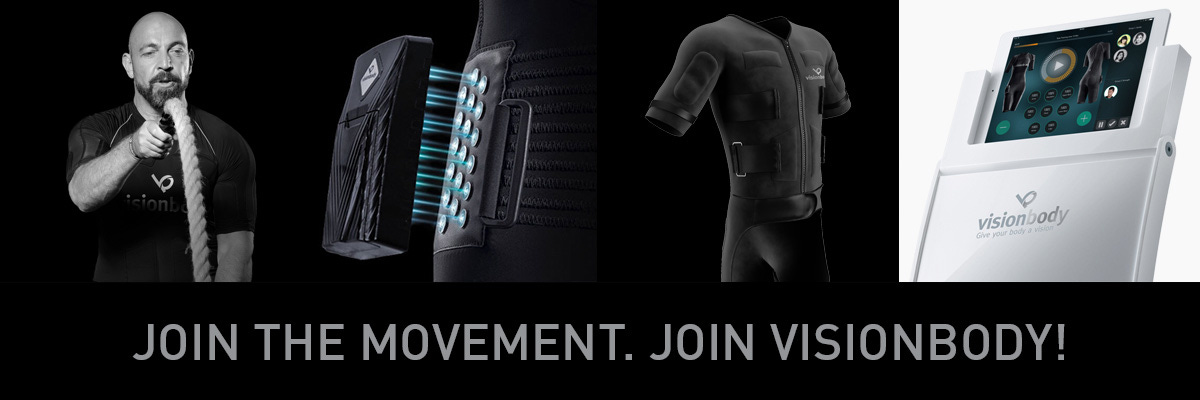Issue #01: Our Top 10 Tips to get started with EMS Training
BLOG: This is how you succeed with your EMS Training program

It can be intimidating to start with ems training. There are countless companies you can go to and a wide variety of ems technology to choose from. There are safety concerns to be aware of, new lingo to understand, and multiple options for each body part.
But these shouldn’t stop you. As great as traditional training is, ems is a perfect complement to your sweat-filled sessions — and sometimes, it’s even better and healthier for your body.
I started ems training in 2016 because of a cool video on Instagram. Today, I exercise frequently, look a decade younger than I am and I have a lower percentage of body fat than when I started. That’s the beauty of ems training - there are multiple benefits to be achieved.
Many people frequently ask me if ems training is not enough or even dangerous!?
I can summarise this up by saying: do the minimal effective training dose, get adequate sleep, get your hydration and nutrition right, switch up your program to avoid boredom, and make sure ems is not your only training routine. It is a super-effective booster to your strength and endurance training routine. And it helps to balance muscle asymmetries in your body.
Before I go any further, I want to clarify: real results take time and persistence. Ems training will not get you your beach body tomorrow.
Above all, there are no magic pills, potions, or drinks you can use to get your best body faster. You must train. And you must train intensely! But safe and healthy!
But let’s figure out how to do this right in the long run:
What Is EMS Training?
EMS means an Electric muscle stimulator. Our advanced suit sends electrical impulses to your muscles to promote muscle contractions or tension. The same happens with regular exercising when you lift weights, move with speed or intensity.
Specifically, Neuro Muscular Electrical Stimulation (NMES) causes Type 1 (slow-twitch) & Type 2 (fast-twitch) muscle fibers to contract, and at multiple Hz levels that provide benefits to your strength, endurance, and recovery training. EMS training with the visionbody system applies tension to your whole body and forcing your muscles to adapt and grow stronger & faster than with regular training. But it is also a perfect add on to your regular training routine like tennis, soccer, running, and fitness training.
What Are The Benefits Of EMS Training?
Among the wealth of benefits EMS training offers, it can help you:
More efficient warm-up: With EMS your Muscles become more metabolically active, so you can become more mobile and stable before your training gets started. Which also lowers the risk of injury.
Lower abdominal fat: Abdominal fat (also known as visceral fat) sits in and around the vital organs, including the heart, placing you at greater risk of disease. Strength training is more effective at reducing abdominal fat than cardiovascular exercise. It works by increasing lean muscle mass which stimulates metabolism, thus helping the body become effective at burning fat.
Prevent injury: Strong muscles mean you also have strong, supporting bones and connective tissue. All of that contributes to a body that can withstand more stress than the bodies of people who don’t do strength exercises. EMS helps you getting stronger no matter what you do!
Stay young and healthy: Studies show that EMS training can enhance heart health, bone health, reduce blood pressure, lower cholesterol, increase bone density, reduce low back pain, and ease symptoms of arthritis and fibromyalgia.
Improves mood: Exercising releases feel-good endorphins which help reduce anxiety and even fight depression.
Increase muscle strength & endurance. EMS training improves not only your muscle mass but also your tissue quality and endurance capacity.
Increase blood flow: Blood circulation is important because oxygen and minerals get to the muscle cells through blood circulation.
What You Need To Know To Get Started With EMS Training
Tip #1: You need a good Warm-Up
A proper warm-up is an important part of an effective strength workout. The purpose of a warm-up is to prevent injury by increasing the body’s core and muscle temperature and move your joints to create smooth movements. Warming up may also help reduce muscle soreness and lessen your risk of injury. In our VTC Workouts, we always warm up first! take a look at our 15, 20, and 25min workouts!
Tip #2: You need to drink water before you train
Before you jump to your training make sure you drank at least 2 glasses of water. To have more body fluids means better performance for your whole body. Your brain, blood circulation, and the electric stimulation feel way smoother than being dehydrated.
Tip#3: Determine the right amount of time and intensity for your training
Figuring out how long and how much % you should be using for a given muscle requires a bit of experimentation. But, it’s better to stay on the side of too light than too intense. You’ll know it’s too light if you can do an entire set with minimal effort. It’s too heavy if your form is sacrificed or it just feels too taxing. Just right is when you feel that the electric stimulus forces your muscles to contract but at the same time, you will be able to move through the whole range of motion of the movement. I recommend starting with 15min and medium intensity.
Tip#4: Do not use any creams or body lotions before the training
Creams and body lotions can block the electricity from getting under the skin. I know that common EMS sense is that your skin needs to be wet before you start. But our suit does not need that. With the visionbody EMS suit, you can start from the beginning without getting wet before.
Tip#5: You can stick to the same workouts each week when you’re starting.
You do not need to complicate things at the start. Unlike experienced trainers like me who can choose a different exercise every day, it is okay for you to stick to the same workouts two or three times a week. Great results can be made by repeating the same workout but increasing intensities as you become better and stronger.
Switching things up can help you avoid a training plateau or boredom, but increasing your training intensities can do the same job for you.
Tip#6: You need to learn proper form
To prevent injuries, you must know the proper form and technique. Proper technique will make sure that you’re working out right without straining.
To maintain proper technique, pay attention to your posture (stand tall with chest lifted and abs held tight), move slowly (this ensures you’re relying on muscles, not momentum, to do the move), and remember to breathe. Many people hold their breath while exerting, but exhaling during the hardest part of the exercise helps fuel the movement.
The best thing about EMS training is that the electric contraction of your muscles is automatically on fire. Tension equals quality. When your body is under tension you can not do any wrong movements because tension holds your body in the proper position like closed muscle chains.
But if your budget allows it, invest in a session with a personal trainer. A trainer can show you the correct positions, grips, and motions while also helping you create a basic strength-training routine.
Tip#7. You need full-body moves to get more functional
Most of us still believe that EMS training is static. Static training got a very big issue! The connection between software (brain) and hardware (muscles) does not work quite well on static training. This is why your EMS training needs to be functional. For a beginner who is only working out a few days a week, a full-body workout works best. This is why we choose a big variety of functional movements for the whole body for our workouts. Full-body workouts maximize your caloric burn and the muscles worked each session.
Tip#8: You need a post-workout stretch routine
Now that you’ve completed your workout, it’s time to stretch it out. Stretching while your muscles are warm can help improve your flexibility, not to mention how good it feels after you’ve pushed yourself hard. Stretching is also great for calming your nervous system. Warm-up stretches include active moves, but in cooling down passive stretches work best. This means holding a stretch for 20–30 seconds as you inhale and exhale deeply.
Tip#9: You need Protein
After a tough sweat, it’s important to refuel. Drink lots of water and thank your body for what it was able to accomplish. A balanced diet helps you avoid fatigue and enables your hardworking muscles to recover after a workout. Protein is important because it stabilizes your blood sugar and helps you feel fuller longer. Studies are clear that men and women who train with EMS devices and refuel their bodies with post-workout protein in fluid form gain more muscle and reduce fat. Don’t skip on food if weight loss is one of your goals; your body needs fuel to perform at its best. And performance is equal to looking awesome and feel your best every day!
Tip#10: Don’t forget to rest & recover
When it comes to working out, rest days are as important as your workout days. Rest is necessary for avoiding exercise-induced fatigue. This recovery process occurs during your rest days and when you sleep or eat.
A rest day doesn’t mean you have to sit on the couch all day. Instead, consider the idea of an active rest day. A bit of movement can increase blood flow thereby reducing soreness and speeding recovery. Consider trying a gentle yoga class, an easy bike ride, or a brisk walk. But sometimes a day of rest, recovery, and laziness is exactly what you need. At the end of the day, you have to focus on how you feel. Soreness is fine, pain is not.
Potential FAQ’s about EMS training
When Will I See Results?
This is a hard question to answer as exercise molds our bodies differently.
Your results are a function of genetics, stress levels, sleep habits, and nutrition.
While you might not lose the pounds immediately lookout for other benefits like improved sleep, more energy, and the ability to handle stress better.
How much calories will i burn in a 15-20min session?
Very important question. You will not like my answer!
Can i combine my EMS training with regular training?
Yes, of course! We believe in functional training! This is why we created the visionbody suit. It is totally wrong to stand in a tiny room and fight the static tension of an EMS device. In our weekly workouts, we present to you with all the training possibilities for you with our unique EMS suit! Give them a try!
What is the best training to burn fat?
Very good questions. It’s strength training! The more active muscles you have the bigger is your caloric consumption of the body. Endurance training can produce the same result but with way more training time and less overall benefits. SO reduce endurance training to 2times per week for no more than 15-25min. Instead, keep moving more throughout the day!

As always, thanks for reading. Keep the comments and corrections coming ;-)
If you have any questions about EMS training please let me know in the comment section!



